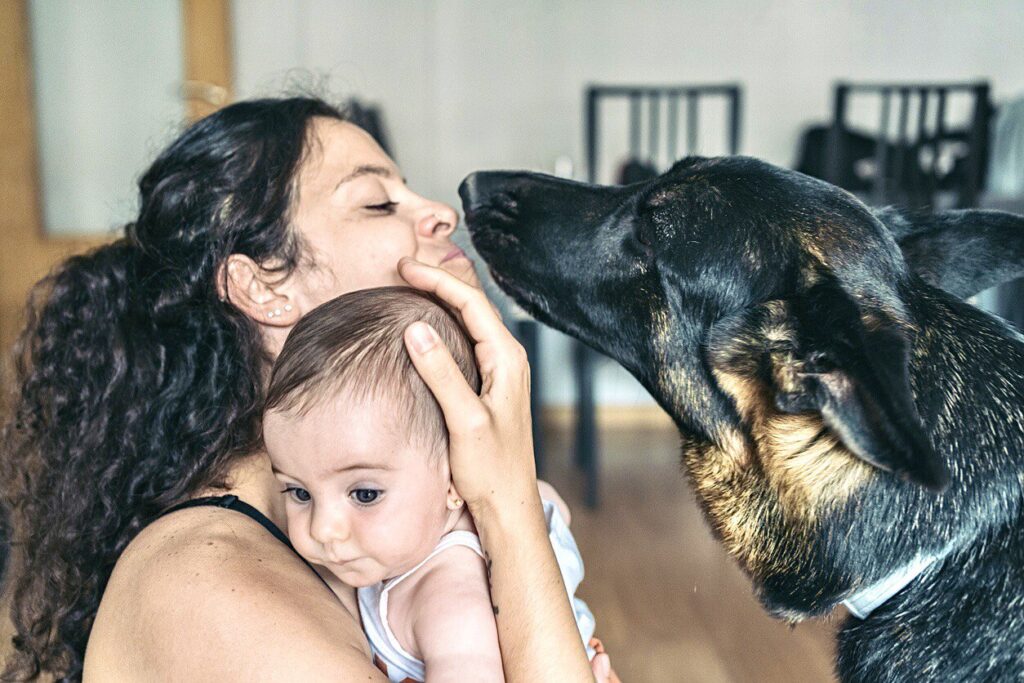1. Inconsistent Routines

Did you know Dogs are creatures of habit? They thrive on consistency in their daily routines. When their schedules are unpredictable, it can create a sense of anxiety for them. For instance, if you usually feed your dog at 7 AM but occasionally skip or delay it, your furry friend may become uncertain about when to expect meals. This unpredictability can lead to stress, making them feel insecure about their environment. Establishing a consistent routine for feeding, walking, and playtime can help your dog feel more secure and relaxed, knowing what to expect throughout the day.
Moreover, changes in your routine can affect your dog’s mood and behavior. If you suddenly start working from home after a long period of being away, your dog might feel overwhelmed by the change in dynamics. They may not know how to adjust to your constant presence, or they could feel anxious when you leave again. Maintaining a consistent routine helps to ease these transitions, allowing your dog to feel more settled and secure in their environment. By providing a stable structure, you contribute significantly to your dog’s emotional well-being.
2. Lack of Exercise

As the popular saying goes, “a tired dog is a happy dog.” This indirectly implies that insufficient exercise can lead to pent-up energy and stress. Therefore, Dogs need regular physical activity to stay healthy and happy; without enough exercise, they may become anxious and engage in destructive behaviors like chewing furniture or barking excessively. Engaging in daily walks, play sessions, or even dog sports can significantly reduce stress levels for both you and your canine companion. A good romp in the park or a game of fetch can work wonders in alleviating anxiety.
Exercise is not just about physical health; it also provides vital mental stimulation. Dogs that are mentally and physically engaged are less likely to experience anxiety. Activities that challenge their minds, like puzzle toys or training exercises, can help keep their minds sharp and reduce stress. By incorporating regular exercise into your dog’s routine, you’ll notice a happier, more relaxed pet. This not only benefits their health but also strengthens the bond between you and your furry friend.
3. Ignoring Signs of Stress

ogs are big on communicating their feelings through body language, and ignoring signs of stress can exacerbate their anxiety. Common signs include excessive barking, panting, or a tucked tail. When you overlook these signals, your dog may feel that their concerns are invalidated, leading to increased stress. Paying attention to your dog’s behavior and responding appropriately can help alleviate their anxiety. Recognizing when your dog is feeling uneasy allows you to take action to comfort them, providing a sense of security.
Additionally, understanding your dog’s unique stress signals is crucial. Each dog may express discomfort differently, and recognizing these signs can help you intervene before their stress escalates. Creating a safe space for your dog to retreat to when they feel overwhelmed can make a significant difference in their emotional well-being. By being attuned to your dog’s needs, you foster a stronger bond and a more relaxed atmosphere, ultimately enhancing their quality of life.
4. Overstimulation

In our busy lives, it’s easy to overlook the impact of overstimulation on our dogs. Loud noises, crowded spaces, and too much visual stimulation can overwhelm a dog’s senses. For instance, taking your dog to a busy park filled with other pets and people can be exciting but also stressful. Providing a calm environment where your dog can unwind is essential for their mental health. Creating a sanctuary at home where your dog can escape the hustle and bustle is beneficial for their overall well-being.
Bringing familiar items from home, such as their favorite blanket or toy, can provide comfort in new situations. These familiar scents can help anchor them and reduce feelings of insecurity. Being mindful of their environment and recognizing when they need a moment to decompress can significantly improve their emotional state. By ensuring that your dog has a peaceful retreat, you can help them recharge and feel more at ease, promoting a happier and healthier life.
5. Unfamiliar Environments

Also, Dogs are creatures of habit and can become stressed in unfamiliar environments. Moving to a new home, visiting a new vet, or even going on vacation can trigger anxiety. The sights, sounds, and smells of a new place can be overwhelming for your dog. Gradually introducing them to new environments can help ease their anxiety and make them feel more comfortable. Taking the time to acclimate your dog to new surroundings can significantly reduce their stress levels.
Additionally, bringing familiar items from home, such as their favorite blanket or toy, can provide comfort in new situations. These familiar scents can help anchor them and reduce feelings of insecurity. Being patient and supportive during these transitions is key to helping your dog adjust and feel secure in unfamiliar surroundings. By providing a sense of familiarity in new situations, you can help your dog navigate changes with confidence and ease.
6. Neglecting Training

Dog owners, it is important to know that training is essential for a dog’s well-being, and neglecting it can lead to behavioral issues and stress. Dogs that lack training may struggle to understand boundaries and expectations, which can create confusion and anxiety. Consistent training not only helps your dog learn commands but also strengthens your bond. Engaging in positive reinforcement training can foster a sense of security and confidence in your dog. When dogs know what is expected of them, they feel more at ease in their environment.
Moreover, training sessions can serve as an outlet for energy and mental stimulation. Incorporating short, fun training exercises into your daily routine can reduce stress for both you and your dog. Regular practice reinforces good behavior and provides your dog with the structure they crave, ultimately leading to a more relaxed and well-adjusted pet. By prioritizing training, you contribute to your dog’s emotional and psychological health, making your time together more enjoyable.
7. Socialization Issues

Proper socialization is crucial for a dog’s emotional health. Dogs that haven’t been adequately socialized may exhibit fear or aggression towards other animals or people. This fear can lead to stress for both the dog and the owner. Gradually exposing your dog to various social situations can help them build confidence and reduce anxiety. Socialization should be a positive experience, allowing your dog to learn how to interact appropriately with others.
Positive experiences during socialization can also create lasting impressions. Introducing your dog to new people, pets, and environments in a controlled manner can help them learn to navigate the world with ease. By prioritizing socialization, you empower your dog to feel more comfortable and secure in different situations. This proactive approach not only benefits your dog but also enhances your relationship, as you both learn to trust each other more deeply.
8. Lack of Mental Stimulation

Just like physical exercise, mental stimulation is vital for a dog’s well-being. Dogs that are bored or under-stimulated may resort to destructive behaviors, leading to stress for both them and their owners. Providing interactive toys, engaging in training sessions, or even teaching new tricks can keep your dog’s mind sharp and satisfied. Mental challenges are just as important as physical activities in keeping your dog happy and content.
Incorporating puzzle toys or treat-dispensing games into your dog’s routine can provide hours of entertainment and mental challenge. These activities not only keep your dog occupied but also help reduce anxiety by channeling their energy into something constructive. By ensuring your dog has plenty of mental stimulation, you contribute to their overall happiness and well-being. A mentally stimulated dog is less likely to engage in problematic behaviors, resulting in a more harmonious living environment.
9. Changes in Family Dynamics

Dogs are very sensitive to changes in their family dynamics, such as the arrival of a new baby or a pet. These changes can disrupt their routine and create feelings of uncertainty. It’s essential to help your dog adjust to these transitions by providing them with extra attention and reassurance. Gradual introductions and maintaining their routine as much as possible can ease their anxiety during these times. This support helps your dog feel secure in their place within the family.
Additionally, involving your dog in family activities can help them feel included and secure. Encouraging positive interactions between your dog and new family members can foster a sense of belonging. By being mindful of their feelings during these changes, you can help your dog adapt and thrive in their evolving environment. Creating a supportive atmosphere during family transitions is key to ensuring your dog remains calm and happy.
10. Inconsistent Discipline

Inconsistent discipline can confuse dogs and lead to stress. When rules are not consistently enforced, your dog may feel unsure about what behaviors are acceptable. This confusion can result in anxiety and frustration for both you and your pet. Establishing clear boundaries and being consistent with training can help your dog understand what is expected of them. Consistency in discipline creates a sense of stability for your dog, allowing them to feel more secure in their actions.
Moreover, using positive reinforcement rather than punishment can create a more relaxed atmosphere. Rewarding good behavior encourages your dog to repeat those actions, leading to a more harmonious relationship. By providing clear guidance and consistency, you can help your dog feel secure and confident in their behavior. This approach not only reduces stress for your dog but also fosters a more enjoyable and cooperative dynamic between you and your furry friend.
11. Neglecting Grooming

Regular grooming is not just about aesthetics; it plays a crucial role in your dog’s health and well-being. Neglecting grooming can lead to discomfort and stress for your dog. Matting fur, dirty ears, and untrimmed nails can cause physical discomfort, leading to anxiety. Establishing a regular grooming routine can help your dog feel more comfortable and relaxed. Grooming sessions can also serve as bonding experiences, allowing you to spend quality time together.
Additionally, grooming helps to keep your dog healthy by preventing issues such as skin infections and matting. Regular brushing can reduce shedding and keep your dog’s coat looking its best. Using gentle techniques and positive reinforcement during grooming can help your dog associate these sessions with positive experiences. By prioritizing grooming, you contribute to your dog’s overall health and happiness, making them feel more at ease in their skin.
12. Overreacting to Their Behavior

As pet owners, it’s natural to feel concerned about our dogs’ behavior, but overreacting can inadvertently increase their stress. If your dog barks at a stranger and you respond with panic, they may interpret your reaction as a signal that something is wrong. This can heighten their anxiety and lead to a cycle of stress. Instead, staying calm and addressing the behavior with positive reinforcement can help your dog feel more secure. Your demeanor plays a significant role in how your dog perceives situations.
Moreover, understanding that dogs may react out of fear or uncertainty rather than malice can shift your perspective. By approaching their behavior with empathy and patience, you create a more supportive environment. This approach fosters trust and helps your dog feel more at ease. By managing your reactions and providing reassurance, you contribute to a calmer atmosphere that benefits both you and your dog.
13. Lack of Quality Time

Dogs are social creatures that thrive on companionship. A lack of quality time with their owners can lead to feelings of loneliness and stress. Spending meaningful time with your dog through play, cuddling, or simply being present can strengthen your bond and reduce their anxiety. Engaging in activities that your dog enjoys, whether it’s fetch, tug-of-war, or leisurely walks, can enhance their overall happiness. Quality time together fosters a sense of security and belonging for your dog.
Being attentive to your dog’s needs and emotions during this time fosters a sense of security. Dogs are incredibly intuitive and can sense your mood, so creating a positive atmosphere during your time together can significantly impact their well-being. By prioritizing quality time, you cultivate a deeper connection that benefits both you and your furry friend. This shared time not only enhances your dog’s emotional health but also enriches your relationship, making every moment together special. Here are 5 things they’re doing that are likely stressing you, too:
1. Excessive Barking

While barking is a natural form of communication for dogs, excessive barking can be a source of stress for both the dog and their owner. Dogs may bark out of boredom, fear, or a desire for attention. When owners respond negatively to barking, it can create a cycle of anxiety for the dog. Understanding the root cause of barking and addressing it calmly can help alleviate stress for both parties. By recognizing the triggers that lead to excessive barking, you can implement strategies to reduce this behavior effectively.
Finding constructive ways to redirect this behavior, such as providing mental stimulation or engaging in training, can help reduce barking. Positive reinforcement for quiet behavior encourages your dog to engage in more appropriate actions. By addressing the underlying issues and fostering a supportive atmosphere, you can create a more peaceful home for both you and your dog, enhancing the quality of your interactions.
2. Chewing on Furniture

Destructive chewing is a common issue that can stem from anxiety or boredom. When dogs chew on furniture or other household items, it can be a sign that they are seeking comfort or relief from stress. Addressing this behavior requires understanding the underlying cause and providing appropriate outlets for their energy. Offering chew toys and engaging in regular playtime can redirect their chewing tendencies. This not only protects your belongings but also gives your dog a healthy way to cope with their feelings.
Ensuring your dog has enough mental and physical stimulation can significantly reduce destructive behaviors. Dogs that are mentally engaged are less likely to resort to chewing on furniture out of boredom. Incorporating interactive toys and puzzle games into their routine can provide the stimulation they need. By providing appropriate alternatives and being proactive in addressing their needs, you can minimize stress for both your dog and yourself, leading to a more harmonious living environment.
3. Jumping on People

Jumping on people can be a sign of excitement or anxiety, and while it may seem harmless, it can lead to stress for both the dog and the person being jumped on. Dogs may jump to seek attention or express their enthusiasm, but this behavior can be overwhelming for guests or family members. Training your dog to greet people calmly can help reduce this stress. This can help alternative behaviors, such as sitting or staying, and create a more relaxed atmosphere during greetings.
Positive reinforcement for calm behavior encourages your dog to engage in more appropriate interactions. This approach not only helps your dog learn better manners but also fosters a sense of security. By addressing jumping behavior with patience and consistency, you can create a more harmonious environment for everyone involved, making visits more enjoyable.
4. Ignoring You

When dogs ignore commands or seem unresponsive, it can be frustrating for owners. This behavior may stem from anxiety or a lack of confidence. Dogs that feel insecure may disengage from their owners, leading to stress for both parties. Building a strong bond through positive reinforcement training can help your dog feel more comfortable and responsive. Creating a positive atmosphere during training sessions encourages your dog to engage actively and trust you.
Furthermore, ensuring that your dog feels safe and secure in their environment is crucial. Creating a calm atmosphere and using positive reinforcement can encourage your dog to engage with you more readily. By fostering a trusting relationship, you empower your dog to feel confident and connected, ultimately reducing stress for both of you. This mutual understanding enhances communication and strengthens the bond you share, making your time together more fulfilling.
5. Seeking Constant Attention

Some dogs may become overly reliant on their owners for attention, leading to stress when they are left alone. This behavior can be a sign of separation anxiety, which can be challenging for both the dog and their owner. Gradually acclimating your dog to being alone for short periods can help them develop independence and reduce anxiety. Providing engaging toys or activities during your absence can help keep your dog occupied and distracted.
Creating a routine that includes alone time can foster a sense of security for your dog. Teaching them that being alone is a normal part of life can help alleviate their anxiety. By balancing attention and independence, you can help your dog feel more at ease and reduce stress for both of you. This approach not only benefits your dog’s emotional health but also allows you to enjoy your time apart without guilt or worry.


